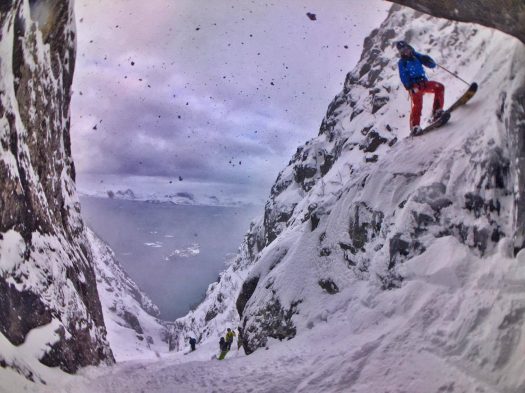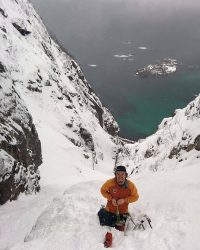Cam McLellan
I recently finished writing a 36 page, 9000-word paper as part two of the three-part Canadian Avalanche Association’s Operation Level 3 course entitled “Applied Avalanche Risk Management”. Normally one wouldn’t associate a PhD-like assignment with what I do, working as an ACMG guide for a living.
But with the industry growing at an alarming rate, it’s really no surprise that risk management is becoming a hot commodity as far as avalanche courses go. Reflecting on what this course has taught me and applying risk management to my daily ski routine, what I do for work and for fun, it has begun to show a new side. It has renewed my interest in alpine travel more than I thought possible.
Now by no means is this a full play by play or total recapitulation of my course and nor is it a shortened summary to entice readers into possible future attendance. This particular article is my take on how this concept of “risk” plays out in the day to day activities that we all love to partake in: backcountry skiing and snowboarding.
“Risk” is “the effect of uncertainty on objectives” as defined by the International Organization for Standardization (ISO). As backcountry enthusiasts, we are continuously subject to adverse and inherent risks on a daily, hourly and even minute by minute basis when out in the boonies seeking the deepest possible pow turns. Whether it’s a risk of frostbite, avalanches, injury, fatigue or any of the several thousand possibilities that we deal with in a day, that risk is out there and we accept it. We welcome it. We search it out.
The usual question is “Why do we seek this out?” Why the heck do we seek out the possibility of being subject to a catastrophic event like an avalanche? Why do we accept the fact that we may lose some digits or the loss of feeling to frostbite — for good? Why is going until we can’t move such a welcome idea? Are we just not that bright?
We accept all of the above and actively head out anyway because it’s just too much fun. If anyone out there feels otherwise about nose deep blower pow you are nuts! (I’m kidding of course).
Well now that we’ve figured out why the heck we head out every time we think the skiing or snowboarding is worth it. The next major step is figuring out how we manage all those parts of the day we try hard to avoid. To save you from the overly dry parts, here’s a few key terms that are applicable to both recreational and professional contexts and make a surprisingly significant difference in your decision making skills once you understand what they mean and how to apply them.
My daily routine both during work and personal ski touring days changed immensely after understanding what these terms meant and how to apply them. I can honestly say that my decision making not only improved but was highly refined at the end of this past winter and having put these concepts into practice. Towards the end of this winter began to use these terms in the stages they are listed above and have developed a simplistic yet refined approach to decision making that I will explain below.
Stage 1. Risk Appetite and Perception – Whether you’re a group of two or ten buddies or guiding a full helicopter of guests: risk perception and appetite are two things you need to understand. This understanding must occur not only on a personal level but as an entire party. Risk perception and appetite in my mind are the fundamentals of group dynamics and managing this is key.
Risk perception is our take on what could potentially happen to us given certain factors but this is easily influenced by bias and experience (i.e. the hard charging buddy to the green beginner telling them the slopes ok to shred together when, they should be spreading out).
Risk appetite on the other hand, is what an individual or group is willing to pursue or retain in order to reach an objective. Both these factors must be balanced and continuity is key regardless of group numbers or context in order to have a successful day.
Stage 2. Operational (or Personal/Group) Risk Band – This particular stage comes after an objective (or two) has been chosen, weather forecasts and avalanche bulletins have been looked at in great detail and a general plan has been decided on for the day.
Operational (Personal or Group) Risk Band is a way of determining how much or how little risk you and your group are willing to take given the current conditions and your objective. Defining a risk band for your group focuses on the given day’s objective and helps refine your plans to optimize risk (think cost-benefit) and get the most out of your day.
This is a key step in any trip itinerary; from what I’ve seen over the years it is usually the “make or break” factor. Knowing what you will do and won’t do ahead of time adds to the ease of decision making and maximizes your time in the deep fluffy pow!
Stage 3. Risk Treatment – This step is all too familiar to most folks. Risk Treatment (or more commonly known as risk mitigation) is what we do during the day to keep ourselves safe. Be it spreading out on steeper terrain, skiing one at a time through avalanche terrain or making the decision to pull the plug and leave our objective for another day. Knowing these tactics is one thing, but practicing them is another and the key to success. Education is always the way to go when it comes to learning about these things but the real crux to mastering any form of risk treatment with regards to backcountry winter pursuits is to practice, practice, practice.
To some folks these may be terms that have been used for quite some time. To others this may be a totally foreign and brand new concept. I’ve personally found these three stages to be of the utmost importance in any backcountry endeavour. Managing risk is something that I, personally, will be learning and re-learning for a long time. It’s a very dynamic concept that requires patience and even then… more patience. For now, hopefully these concepts will be of use to folks who take it upon themselves to have a read through my words. It’s an amazing thing that we all love, skiing and snowboarding in the backcountry. We just have to make sure we do it safe.
(WildSnow guest blogger Cam McLellan has an infectious love for backcountry skiing and sharing his passion with others. This has been life for Cam as he knows it since a very early age. Realizing that he could turn this passion into a job, Cam actively pursued a career as an ACMG guide straight out of high school and hasn’t looked back. Moreover, he has actually never “worked” a single day in his life since then. Follow him on Instagram, camskiguide.)
Beyond our regular guest bloggers who have their own profiles, some of our one-timers end up being categorized under this generic profile. Once they do a few posts, we build a category. In any case, we sure appreciate ALL the WildSnow guest bloggers!


